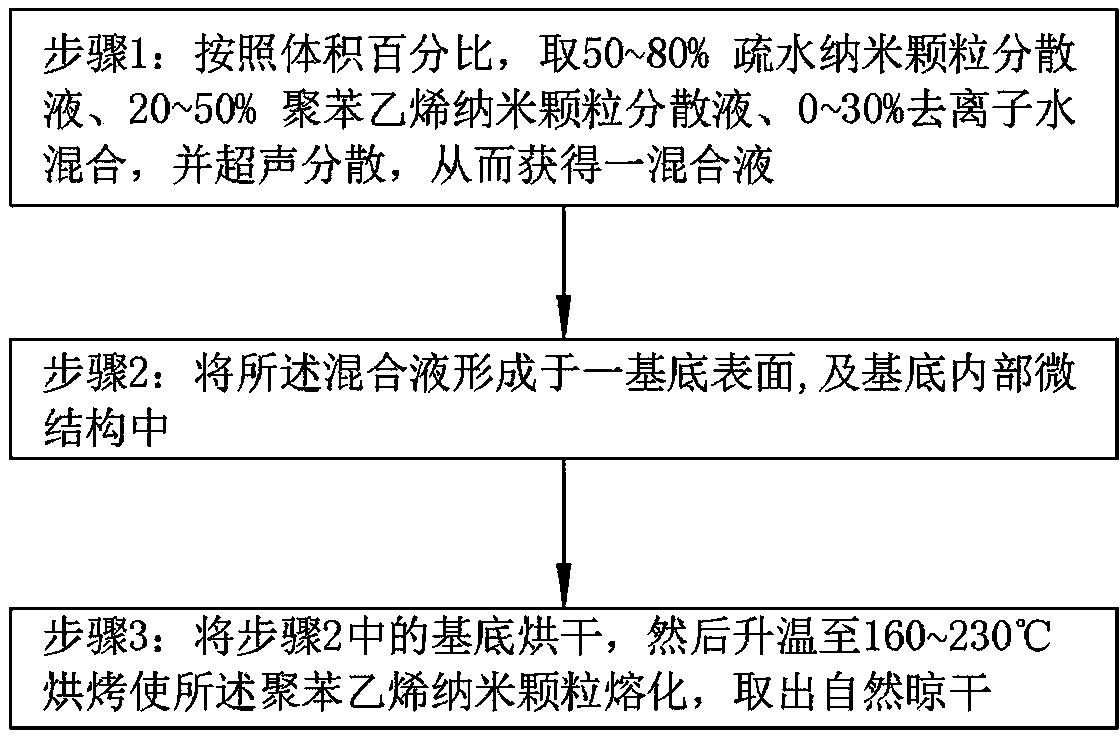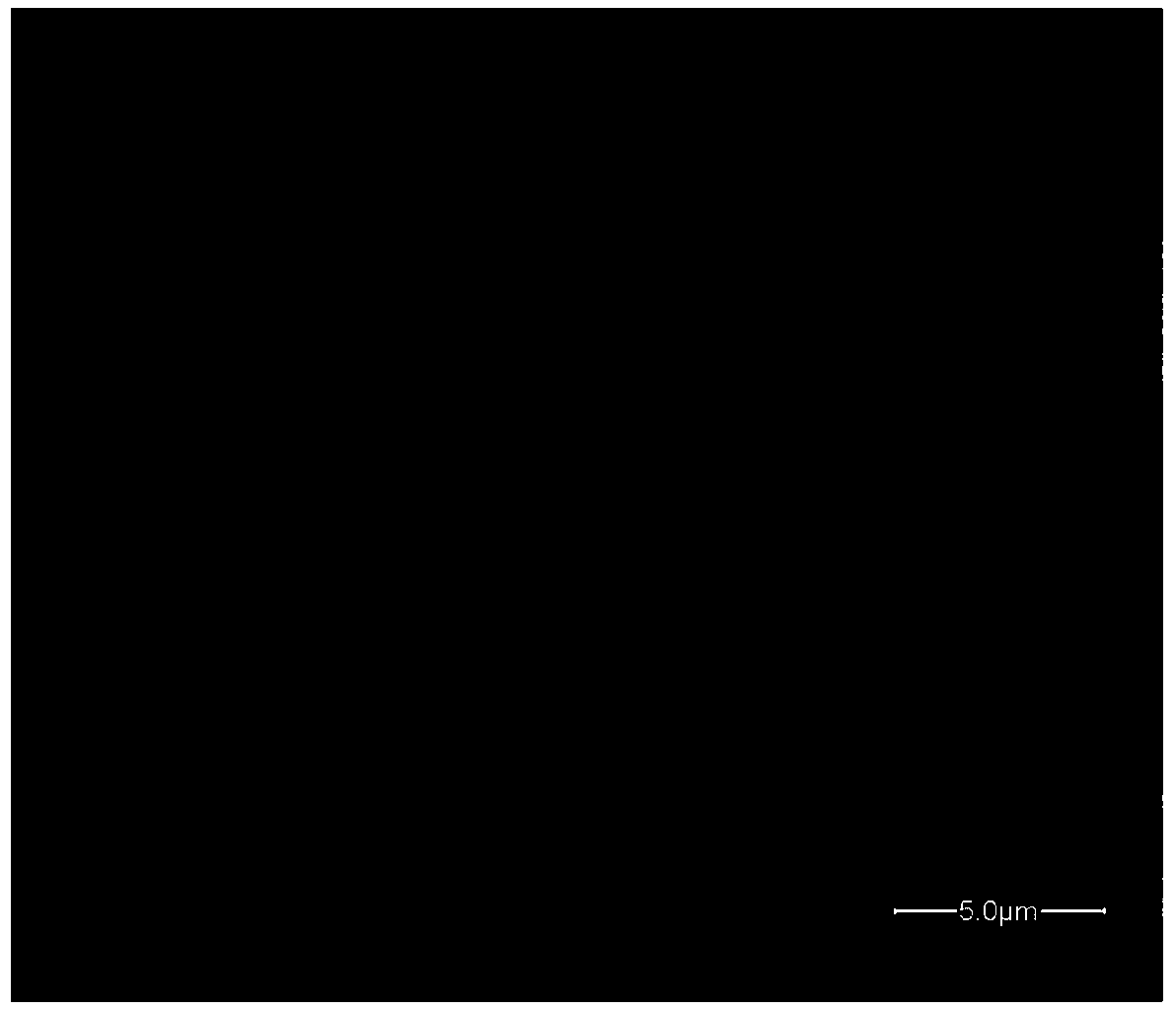Superhydrophobic paint, superhydrophobic coating and preparation method thereof
A technology of super-hydrophobic coating and super-hydrophobic coating, applied in coating and other directions, can solve the problems of insufficient stability of super-hydrophobic surface, insufficient tolerance, unfavorable industrial production, etc., to achieve good reusability and service life, and not easy to age. Ineffective, simple effect
- Summary
- Abstract
- Description
- Claims
- Application Information
AI Technical Summary
Problems solved by technology
Method used
Image
Examples
preparation example Construction
[0019] Please refer to figure 1 , the embodiment of the present invention provides a kind of preparation method of superhydrophobic coating, it comprises the following steps:
[0020] Step 1: According to the ratio of parts by volume, take 50-80 parts of hydrophobic nanoparticle dispersion with a mass fraction of 2% to 15%, 20-50 parts of polystyrene nanoparticle dispersion with a mass fraction of 1% to 10%, 0~30 parts of solvents are mixed and ultrasonically dispersed to obtain a mixed solution;
[0021] Step 2: forming the mixed solution on the surface of a substrate and in the microstructure inside the substrate;
[0022] Step 3: Dry the substrate in step 2, then heat up to 160-230°C and bake to melt the polystyrene nanoparticles, take it out and dry it naturally.
[0023] In step (1), the hydrophobic nanoparticle dispersion can be obtained by dispersing the hydrophobic nanoparticles in a solvent, or by suspension polymerization, emulsion polymerization and other polymeri...
Embodiment 1
[0036] Take 60 parts (parts by volume) of polytetrafluoroethylene dispersion with a mass fraction of 6%, 20 parts of polystyrene dispersion with a mass fraction of 2.5%, and 20 parts of water, and then ultrasonically disperse to obtain a mixed solution, wherein, The particle size of the polytetrafluoroethylene is about 220nm, and the particle size of the polystyrene is about 200nm; use a high-density cotton cloth (average pore size less than 200 microns) as the substrate, and immerse it in the mixed solution to deposit 20 minutes; take out the high-density cotton cloth immersed in the mixed solution, put it in a drying oven at 70°C for 30 minutes, and finally raise the temperature to 220°C for 20 minutes, take it out and dry it naturally to obtain a superhydrophobic cotton cloth. After testing, the contact angle of the superhydrophobic cotton cloth to water is greater than 150°. In addition, the contact angle of the super-hydrophobic cotton cloth to oil (n-hexane, n-hexadecane...
Embodiment 2
[0038] This embodiment is basically the same as the above-mentioned embodiment 1, except that a polyester or polypropylene non-woven fabric is used as the base and immersed in the mixed solution, wherein the average pore size of the non-woven fabric is less than 200 microns. Thereby superhydrophobic polyester or polypropylene non-woven fabrics are obtained. After testing, the contact angle of the hydrophobic polyester or polypropylene nonwoven fabric to water is greater than 150°. At the same time, the hydrophobic polyester or polypropylene non-woven fabric has a contact angle of 0° to oil (n-hexane, n-hexadecane, chloroform, gasoline, silicone oil, etc.), so it can also be used for oil-water separation. The hydrophobic polyester or polypropylene non-woven fabric has a separation efficiency of more than 99% for mixtures of oil (n-hexane, n-hexadecane, chloroform, gasoline, silicone oil, etc.) and water.
PUM
| Property | Measurement | Unit |
|---|---|---|
| particle diameter | aaaaa | aaaaa |
| thickness | aaaaa | aaaaa |
| thickness | aaaaa | aaaaa |
Abstract
Description
Claims
Application Information
 Login to View More
Login to View More - R&D
- Intellectual Property
- Life Sciences
- Materials
- Tech Scout
- Unparalleled Data Quality
- Higher Quality Content
- 60% Fewer Hallucinations
Browse by: Latest US Patents, China's latest patents, Technical Efficacy Thesaurus, Application Domain, Technology Topic, Popular Technical Reports.
© 2025 PatSnap. All rights reserved.Legal|Privacy policy|Modern Slavery Act Transparency Statement|Sitemap|About US| Contact US: help@patsnap.com



